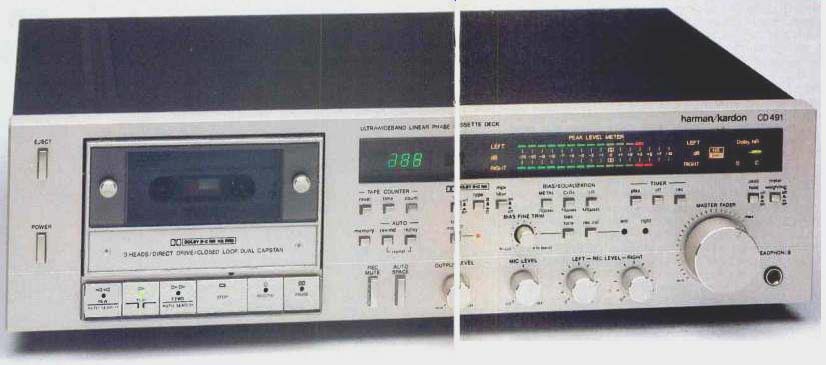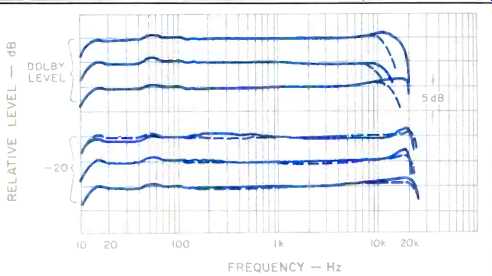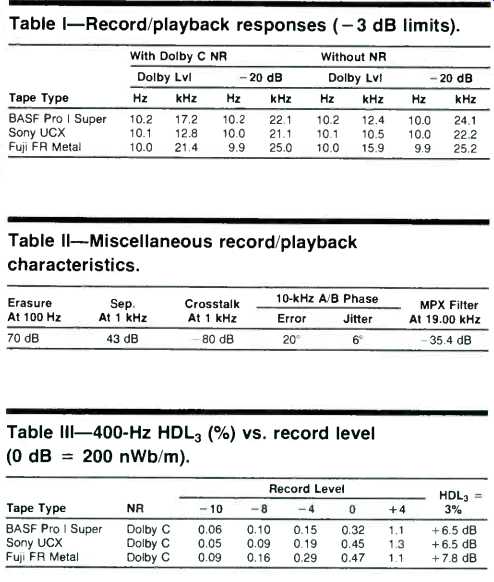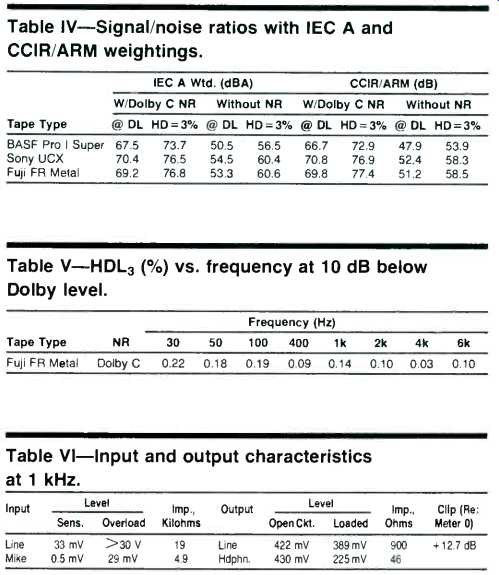
Manufacturer's Specifications
Frequency Response: 20 Hz to 24 kHz, to 26 kHz with metal tape.
Signal/Noise Ratio: 66 dB with Dolby B NR, 75 dB with Dolby C NR.
Input Sensitivity: Mike, 0.8 mV; line, 40 mV.
Output Level: Line, 420 mV.
Flutter: 0.025% wtd. rms, ±0.04% wtd. peak.
Fast-Wind Times: 70 S with C-60.
Dimensions: 17-7/16 in. (443 mm) W x 4-13/16 in. (123 mm) H x 14 in. (355 mm) D.
Weight: 15.9 lbs. (7.2 kg).
Price: $785.00.
Company Address: 240 Crossways Park West, Woodbury, N.Y. 11797, USA.
Harman/Kardon calls the CD491 an "ultra-wideband linear-phase cassette deck," which certainly sounds good and arouses the curiosity of testers and users alike. The front panel is a very light beige, and the black designations are easy to read under any normal lighting. When the power switch is pushed on, "Wait" appears in red on the meter/ display panel. After 7 seconds, it turns off, and "0" appears in the counter readout to the left. The counter displays up to four digits ("2310" for one side of a C-90), but leading zeros are blanked out-a nice touch. Counting below zero in rewind is from "9999" down. A push of "Time," and the counter will show play or record time in minutes and seconds, which is a very helpful feature. The time/position reference is not maintained during fast-wind modes; instead, the display automatically switches to normal counter mode. Therefore, you can't locate passages on tape by their timing, or estimate remaining time if you start in mid-tape.
With "Rewind" alone pushed in, the deck will rewind to the beginning of the tape and stop. If "Replay" is actuated at the same time, the deck goes into play instead, and the process continues until interrupted. If "Memory" is enabled, the basic action is the same, but the stop on rewind is at "0000." There are three pushbutton switches of the same design for noise-reduction settings: "Off/On," "B/C" and multiplex filter "On/Off." Status indicators for "B" (green) and "C" (yellow) are located at the opposite end of the display panel, to the right of the meters. The filter is off when its switch is pushed in, the reverse of what I had expected. Just below the NR pushbuttons is the tape monitor switching, which latches in for tape playback, turning on a red LED at the same time.
To the right of the noise-reduction switches are "Bias/ Equalization" controls. Three interlocked tape-select switches are on the top row, for "LN" (Type I), "CrO2" (Type II), and "Metal" (Type IV). Just below are momentary-contact "Bias Tone" and " Rec Cal" pushbuttons, both used in the calibration procedure. With "Bias Tone" pushed in, 400 Hz is fed to the left channel and 12.5 kHz to the right. "Bias Fine Trim," to the left of the button, is adjusted to match the indicated channel levels in playback. This trim control has a center detent, and labels remind the user that rotation to the left reduces the highs, while rotation to the right boosts them.
When " Rec Cal" is pushed in, 400 Hz is fed to both channels. A supplied adjustment tool is put into the "Left" and "Right" holes, in turn, to set the indicated levels to meter zero, thus ensuring good Dolby tracking. The interlocked "Play/Off/Rec" switches for timer operation are just above.
The horizontal bar-graph-type meters have 16 segments. They cover from 30 to + 10 dB, With light green LEDs from "-30" to "-1," yellow from "0" to "+2" and red for "+3" to "+ 10." Dolby level is at meter zero, which helps to minimize confusion, in my view. The "HX PRO" logo, just to the right, announces the incorporation of this latest version of circuitry for high-end extension. Normally, the peak-responding meters do not hold peak readings, but with a push of "Peak Hold," maximum indications will be held about 2 seconds, which aids in the level-setting when recording. The unique "Meter Weighting" button equalizes the meter amp to the inverse of the saturation curve of tapes recorded on the CD491. In the weighted mode, the first red meter LED ("+3") indicates the tape overload point. The effect, as with the more common scheme of metering the signal after record EQ, gives a much better indication of the possibility (or probability) of reaching high-frequency saturation. The switch also allows for so-called normal metering.
Along the bottom of the front panel are four level-control knobs of medium size with very fine knurling for easy turning. The left and right "Rec Level" pots control only the line inputs. The "Mic Level" control affects both channels, providing full mixing, and there is a soft detent at the "Off" position-to help prevent it from being turned up inadvertently. The "Output Level" pot controls both line and headphone outputs, but it has no effect on meter indications.
The "Master Fader" sets the level for the two-channel mix. This large knob makes for very easy setting at any point up to its maximum rotation, which is just 180°-different from most pots, but just fine in practical use.
The transport-control switches, beneath the cassette compartment, have light-touch plates with status lights for all functions (except "Stop"). The logic allows you to change directly from any mode to any other mode, including going into record mode while in play. In "Pause" or record/pause mode, the indicator on "Play" flashes, telling the user that it is the button to push next. Simultaneously pushing "Play" and either fast-wind switch engages "Auto Search," which finds the beginning (or end) of the current selection, then automatically resumes play.
Immediately to the right of the transport controls are momentary-contact switches labeled "Rec Mute" and "Auto Space." The latter provides an automatic muting for 5 seconds and then a switch into record/pause. Whenever there is muting, the "Record" indicator flashes (instead of glowing), reminding the user that no signal is being recorded.
The cassette-compartment carrier swings down briskly with a push of "Eject," at the upper left corner of the front panel. Loading and maintenance are easy tasks, as they are for most front loaders these days.
The "Headphones" jack is on the front panel (at the lower right corner), but the two microphone jacks are on the back, which seems unnecessarily out of the way. A single microphone plugged into either jack is fed equally to both channels, which gives a little more convenience than having just one jack provide the mono function. The line in/out jacks, of course, are also on the back panel.
My internal inspection found two large p.c. boards that combined to fill the chassis, with a metal partition between them acting as both shield and heat-sink. Soldering was excellent, with slight flux residue at a couple of points. All parts and adjustments were labeled, and the components were of high quality and well laid out. There were two fuses in clips. A listening check proved the quietness of the dual capstan drive. The removed top-and-side cover had what appeared to be vibration-damping pads on its interior surface, an unusual attention to detail to minimize distracting noises.
Measurements
The playback responses were checked using TDK and BASF alignment tapes. Most points were within ± 1.5 dB, but there was some additional boost at the low end from fringing effects, and the high end was down almost 3 dB at 10 kHz and more at higher frequencies. It appeared likely that there would be some benefit from a touch-up azimuth alignment, which is actually a good idea for any deck about to be put in use. Playback level indications were close, within the resolution of the meter segments. Playback tape speed was just 0.2% slow.
The CD491 record/playback performance was checked with many different tape formulations of all types, except Type Ill (ferrichrome). The bias adjustment range extended far enough down to handle even non-premium Type I tapes, but it did not quite reach high enough for tapes whose bias requirements are relatively high for their type, such as Maxell XL I-S, Sony AHF and TDK AD-X (all Type I), and Memorex HBII (Type II). Results were excellent with the manufacturer's reference tapes, Maxell XL I and TDK SA and MA, but I had a slight preference for the response shapes of BASF Pro I Super, Sony UCX and Fuji FR Metal, so I used them for the detailed testing that followed.

Fig. 1--Frequency responses with (solid lines) and without (dashed lines)
Dolby C NR, using Type I (BASF Pro I Super), Type II (Sony UCX), and Type
IV (Fuji FR Metal) tapes.
Figure 1 shows the swept-frequency responses at Dolby level and 20 dB below that for these three tapes, both with and without Dolby C NR. As the data in Table I demonstrates, the responses are extended at both ends of the band under all conditions, certainly improved at the high end by HX Pro. The responses are outstanding, both for their flatness from below 20 Hz to 10 to 20 kHz and for their excellent Dolby NR tracking. This latter result proves the success of the Harman/Kardon deck's two-tone calibration.
With Sony UCX tape, the 400-Hz (403-Hz actual) level could be set anywhere from-4 to +2.5 dB relative to meter zero. The bias control varied this tape's output of the 12.5-kHz (actually 11.6-kHz) tone from-2 to +4.3 dB on the meter. Both test tones had distortion of about 1%, plenty low enough for the purpose.
Table II lists the excellent results of other record/playback tests. The 70-dB erasure figure at 100 Hz held true even with metal tape, definitely better than most decks can do.
Third-harmonic distortion (HDL3) was measured from 10 dB below Dolby level to the limit of 3% distortion for the three tapes with Dolby C NR. The results are uniformly excellent and quite superior to those from the great majority of decks. Since noise is measured relative to the signal level at which this 3% limit is reached, with the CD491's low distortion, raising this level effectively raises the signal-to-noise ratios. This is indicated by the excellent results shown in Table IV for all three tape types. The distortion was also measured as a function of frequency with Fuji FR Metal tape at-10 dB, from 30 Hz to 6 kHz. The low distortion at all points is judged to result from the success of HX Pro as well as the basic low-distortion performance.
Table VI lists the input and output characteristics at a test frequency of 1 kHz. All of the results were equal to or better than specification. The line-input overload level was above the 30-V limit of the driving amplifier. The output test loads were 10 kilohms for line and 50 ohms for headphones.
There was high volume to all headphones tried, easily controllable with the output pot. If a single microphone input was used, the left-channel level was 1.5 dB higher than that of the right channel, which would shift this mono image slightly to the left. The sections of the mike input pot tracked within 1 dB for up to 60-dB attenuation from maximum gain.
The master pot, on the other hand, tracked for just 20 dB to the same 1-dB limit. It would be best to keep it near maximum when matching channel levels. The deck had low sensitivity to internal overload at meter zero, even with the master set at lower clockwise rotation than the channel pots.
This is a good feature of this deck, but it's still normally good practice to keep the master at least as open as the channel pots when operating. The output polarity was the same as the input, whether in source or tape monitor, which is the preferred configuration.
The peak-responding meters were truly that, as they met the requirements of IEC Standard 268-10 for peak-program meters. The thresholds for most of the segments were very close to their designated values, particularly from "-2" to "+ 10." The lower segments turned on at levels much higher than designated, however, with "-30" at-21 actual and ' 20" at-15 actual, for example. With meter weighting out, the response was 3 dB down at 10.7 Hz and 40.0 kHz. With weighting switched in, the high-frequency boost was 5 dB at 5 kHz, 10 dB at 10.6 kHz, 13 dB at 15.5 kHz and the maximum + 17 dB at 26.6 kHz. I prefer metering with this post-EQ boost, for it is much more indicative of saturation and distortion limitations across the band.
The flutter measured on the Harman/Kardon deck varied a bit with the cassette selected. It was possible to find some that met the specifications of 0.025% wtd. rms and ± 0.04% wtd. peak, which are very low figures indeed. More typical figures in my measurements were 0.032% wtd. rms and ±0.044% wtd. peak, which are slightly higher, but excellent.
Tape play speed varied very slightly with changes in line voltage, up less than 0.01% at 130 V. There were fairly regular speed variations of a minor nature, always less than 0.025%. The fast-wind times for a C-60 were 71 S. Most changes in transport mode were accomplished in 1 S or less.

Table I-Record/playback responses (-3 dB limits).
Table II-Miscellaneous record/playback characteristics.
Table III-400-Hz HDL3 (%) vs. record level (0 dB = 200 nWb/m).

Table IV-Signal/noise ratios with IEC A and CCIR/ARM weightings.
Table V-HDL3 (%) vs. frequency at 10 dB below Dolby level.
Table VI-Input and output characteristics at 1 kHz.
Use and Listening Tests
The owner's manual has good, lucid text with nice detailing on recording, setting levels, bias trimming, and record sensitivity calibration. The illustrations are good, but there's no block diagram, which would have been nice. Maintenance was basically easy to do, although I wished the thumbscrews for the door cover were captive. All controls and switches were completely reliable during the testing.
After a number of decks with automatic tape-type sensing, I did have to remind myself to push the tape-matching selector switch. As I usually check bias trim and record calibration, this was really no inconvenience.
The metering was excellent in use, certainly one of the best for dynamic responses, and further improved with the weighting switched in. It was possible to set maximum levels very quickly and with more assurance than when metering without the weighting. The peak-hold feature was a further aid to getting the maximum out of the tapes. A check of record, pause and stop clicks showed that they were very low, just a bit out of tape noise with Dolby C NR. There was no evidence of any Dolby mistracking at any level with any of the tapes, showing what can be done with good deck setup and excellent responses to start with.
I enjoyed much pleasurable listening, from sources such as The Empire Strikes Back (Charles Gerhardt and the National Philharmonic Orchestra, dbx version of Chalfont SDG 313) and Mobile Fidelity's Kim Carnes' Mistaken Identity (MFSL 1-073) and The Planets by Holst (Solti and the London Philharmonic Orchestra, MFSL 1-510). The time function of the counter was helpful in fitting certain pieces onto partly recorded tapes.
The Harman/Kardon CD491 lacks a number of sophisticated microprocessor-controlled features, and it doesn't have automatic tape calibration or tape-type sensing, but recorders with such a collection of features cost a lot more.
For its sizable price, this deck provides superb frequency responses, a convenient and accurate calibration scheme to match most tapes, excellent Dolby NR tracking, very low noise and distortion with all three tape types, very low flutter, good mike/line mixing, and excellent metering. Where the final tape is the criterion, the CD491 is worthy of comparison to other decks at up to twice its price.
-Howard A. Roberson
(adapted from: Audio magazine, Mar. 1984)
= = = =
Also see:
Harman Kardon CD491 Cassette Deck (ad, Nov. 1984)
harman/kardon VCD1000 High Fidelity Audio/ Video Cassette Deck (Feb. 1985)